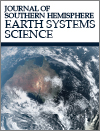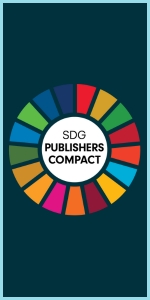Journal of Southern Hemisphere Earth Systems Science
Volume 75
Number 2 2025
Predicting PM10 is crucial in addressing air pollution in large cities such as Bandung. The WRF-Chem model, commonly used with global emission data, can potentially provide better predictions with regional emission data. Here, we show that although the model ran successfully with regional data, the predictions contain significant errors, suggesting it cannot yet accurately predict PM10 in the Bandung Basin.
Two extreme wind case studies in Tasmania are investigated. The efficacy of a probabilistic wind gust diagnostic, based on ACCESS-CE model output, is assessed in each case. For these events, the diagnostic was found to usefully summarise model information about the timing, intensity and extent of the extreme winds.
Air pollution is unequally monitored in Brazil, despite its relevance and health impacts. Global atmospheric model estimates can fill this lack of data after validation against air pollution observations. This study evaluates two global models and finds that one of them reproduces the seasonal variation of air pollution in the metropolis of São Paulo. After the necessary corrections, model estimates can be used to assess air pollution conditions in regions where direct observations are absent.
Severe Zonda windstorms in Argentina produce intense, gusty, warm and dry conditions that result in significant socioeconomic impacts. This study examines the atmospheric dynamics driving long-duration severe events, highlighting the role of stronger pressure systems, enhanced upper- and lower-level winds and more intense cross-Andes flow. These findings enhance our understanding of severe Zonda windstorms and provide insights that could improve weather forecasting and help mitigate their impacts on affected communities.
Regional high-resolution climate models (RCMs) provide insights for assessing future climate hazards and risks. Determining the ability of RCMs to simulate present day rainfall and temperatures is critical to inform model use. We apply a novel benchmarking framework to assess RCMs’ ability to simulate Australia’s current climate. Across latest projections produced by four modelling centres, no climate simulation consistently fails the majority of benchmarks. We conclude that the full multi-model ensemble is fit for use in the Australian region.
Record floods and record mean sea levels are occurring more often than would be expected if sea level rise was not occurring. Our results imply that higher sea-level rise scenarios are most consistent with the continuation of recent trends.
The Bureau of Meteorology provides vital marine services that strongly depend on guidance from a suite of numerical weather prediction models. These models have vastly improved skill because of increased resolution, enhanced data assimilation (increasing numbers and types of observations), and improved physical parameterisations – and are verified against satellite and wave buoy observations. Compared to the legacy wave model and the European Centre for Medium-Range Weather Forecast reanalysis ERA5, the Bureau’s global wave forecast system shows increased skill.
The 2023 El Niño significantly affected weather patterns across the Indonesian Maritime Continent (IMC). Using ERA5 data, this study analyses these effects. Findings reveal that, while the northern IMC exhibited increased rainfall due to the warming of the South China Sea, the southern IMC experienced severe drought exacerbated by the positive Indian Ocean Dipole and weakened easterly winds. This study improves understanding of the diverse impact of El Niño on intraseasonal weather to enhance seasonal climate predictions over the IMC.
Seasonal variations in coastal sea level associated with climate variability such as El Niño are known to influence the frequency of coastal flooding around Australia. In this article we show that, using the Australian Bureau of Meteorology’s seasonal prediction system ACCESS-S2, seasonal coastal sea level variations can be forecast accurately up to 8 months ahead of time. These seasonal forecasts will form an important component of an early warning system under development to improve community resilience to coastal flooding hazards.
This study explores the impact of Mid-Holocene terrestrial changes, particularly the Green Sahara and African mega-lakes, on South Atlantic oceanic and atmospheric dynamics using NASA GISS E2.1-G climate model simulations. Findings highlight significant alterations in sea surface temperatures, salinity, circulation patterns and atmospheric dynamics, underscoring the critical role of vegetation and hydrology in modulating regional climate during this period. The research provides valuable insights into the interconnected nature of Earth’s climate systems, with implications for understanding past climate variability and future changes in the Southern Hemisphere.
How variable is Australian climate and how will this change in a warmer world? The interannual variability of rainfall, temperature, pressure, moisture flux and winds is assessed using gridded observations and climate model output. Australian climate variability is typically somewhat larger than over global land. There is a small increase for 2°C global warming, in part linked to El Niño–Southern Oscillation (ENSO).
Two events, one affecting north Queensland from Tropical Cyclone Jasper in December 2023 and the other in Auckland, New Zealand, in January 2023 produced record rainfall. Analyses of wind and thermal structure found that multiple factors occurring simultaneously were responsible for the extreme rainfall for both events. Similar events today would be worsened by global warming causing rising sea levels.




